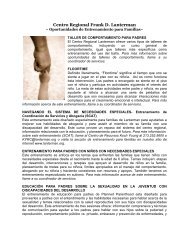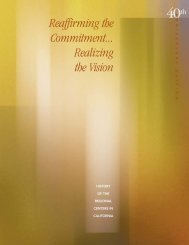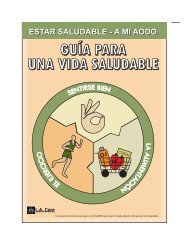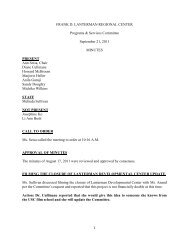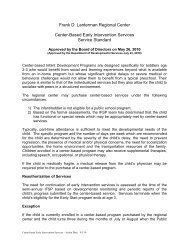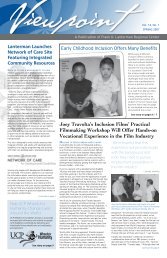Conservatorship - Frank D. Lanterman Regional Center
Conservatorship - Frank D. Lanterman Regional Center
Conservatorship - Frank D. Lanterman Regional Center
You also want an ePaper? Increase the reach of your titles
YUMPU automatically turns print PDFs into web optimized ePapers that Google loves.
<strong>Conservatorship</strong>A Booklet for <strong>Lanterman</strong> <strong>Regional</strong> <strong>Center</strong> Families
Table of ContentsIntroduction...................................................................................................................................1How <strong>Conservatorship</strong> Works............................................................................................2Types of <strong>Conservatorship</strong>s Recognized in California...................................2Mental Health <strong>Conservatorship</strong>............................................................................................2Probate <strong>Conservatorship</strong>...........................................................................................................2General <strong>Conservatorship</strong>...................................................................................................2Limited <strong>Conservatorship</strong>...................................................................................................3Limited <strong>Conservatorship</strong>.....................................................................................................3Limited <strong>Conservatorship</strong> of the Person.............................................................................3Limited <strong>Conservatorship</strong> of the Estate..............................................................................4Determining if Your Child Needs Limited <strong>Conservatorship</strong>.................................4When to Apply for a Limited <strong>Conservatorship</strong>.............................................................5Eligibility to be a Conservator.........................................................................................5Establishing <strong>Conservatorship</strong>..........................................................................................6Temporary <strong>Conservatorship</strong>....................................................................................................6<strong>Regional</strong> <strong>Center</strong> Role in <strong>Conservatorship</strong>s......................................................................6Next Steps After a <strong>Conservatorship</strong> is Granted by the Court................7Filing a Care Plan..........................................................................................................................7Filing an Accounting...................................................................................................................7Duration of a Limited <strong>Conservatorship</strong>............................................................................7The Court’s Continuing Role in the <strong>Conservatorship</strong>...............................................7Additional Information, Resources and Assistancewith Filing for a Limited <strong>Conservatorship</strong>.............................................................8Notes
IntroductionAs your child with special needs approaches the age of 18 andbegins to transition into adulthood, there are many changesthat you, as their parent, need to take into consideration and beprepared for. One of these changes is that under the law, yourchild at the age of 18 will be viewed as an adult, and will havethe right to make all decisions about his or her life, includinghealth care, finances, work or school, social life and livingsituation regardless of the level of your child’s special needs.The question you need to ask yourself is whether yourchild is ready and has the ability to make adult decisionsindependently. If you believe that your child’s disability limitshis or her capacity to do so, or that your child is subject toundue influence, there is a way that you can remain involvedand continue to protect your child’s well-being while at thesame time encouraging him or her to exercise self-reliance .and independence. This is through a legal proceeding .called conservatorship.Generally, conservatorship for adults with developmentaldisabilities is achieved through a limited conservatorship (othertypes of conservatorship are available in California), which isa court proceeding where a judge gives a responsible person(called a limited conservator) certain rights to care for an adultwith a developmental disability who has a limited capacity tomake decisions independently (called a limited conservatee),enabling them to act on behalf of an adult in one or more lifeareas, subject to periodic reviews by the court.Not all adults with developmental disabilities require a limitedconservatorship, and in some cases, if the main objective is themanagement of the funds of a person with a developmentaldisability, a special needs trust or representative payeeship canbetter meet those objectives.A Booklet for <strong>Lanterman</strong> <strong>Regional</strong> <strong>Center</strong> Families 1
How <strong>Conservatorship</strong> Works<strong>Conservatorship</strong> is a legal proceeding through which an individual or agency (theconservator) is appointed by the court to protect and manage the personal care orfinances, or both, of someone 18 years of age or older (the conservatee) who hasbeen found by the court to be unable to do so for himself or herself. A conservatorwho is given authority to manage the personal care of another is called “conservatorof the person.” A conservator who is responsible for another person’s finances iscalled “conservator of the estate.” You can be appointed either conservator of theperson or conservator of the estate, or both, depending on the needs of your child.Before the court will agree to appoint a conservator of the person, it must be shownthat the proposed conservatee is not able to adequately make decisions concerning hisor her own personal needs, including medical care, residence or education. Similarly,a conservator of the estate may be appointed if a person has been shown to be unableto manage his or her own financial resources, or unable to resist fraud or “undueinfluence” by another. Along with the authority to make decisions for the conservatee,the conservator has a responsibility to make choices that support the conservatee’swishes and encourage maximum potential.Types of <strong>Conservatorship</strong>s Recognized in CaliforniaTwo types of conservatorships are recognized in the state of California. Mentalhealth conservatorships, generally referred to as an L-P-S conservatorship, andprobate conservatorships which are referred to by this term because they are definedin laws found in the California Probate Code and may either be general or limited.Mental Health <strong>Conservatorship</strong>A 1969 California law, called the <strong>Lanterman</strong>-Petris-Short Act, created a legalconservatorship (generally referred to as an L-P-S conservatorship) intended to protectpeople, including adults with developmental disabilities, whose serious mental illnesslimits their ability to provide for their own needs for physical care, food, clothing orshelter. It allows the conservator to make decisions for the person in a number of areasof life, and to arrange for certain kinds of restrictive living arrangements and mentalhealth treatment if the person is unable or unwilling to accept these things voluntarily.Probate <strong>Conservatorship</strong>General <strong>Conservatorship</strong>The general conservatorship was established for adults who are unable to care forthemselves or manage their own finances. People subject to general conservatorshipsare often elderly, with limitations associated with the aging process. This typeof conservatorship may also be applied to people who are seriously impaired foranother reason, such as from an accident or illness.2<strong>Conservatorship</strong>
Limited <strong>Conservatorship</strong>The limited conservatorship was created specifically for adults with a developmentaldisability who may need help or support in specific life areas, but who do not needthe higher level of supervision provided by a general conservatorship.The remainder of this document focuses on limited conservatorship as it applies toindividuals with developmental disabilities. 1Limited <strong>Conservatorship</strong>This protective legal status is “limited” because it applies only to areas of theconservatee’s life or finances that – in the judgment of the court – he or she isunable to manage independently. In other words, the conservatee retains all legaland civil rights not specifically addressed in the conservatorship order.Limited <strong>Conservatorship</strong> of the PersonThere are seven areas of a person’s life to which a limited conservatorship of theperson may be applied. A conservator has authority (called a “power”) only in theareas where such authority is specifically granted by the court. The court may granta conservator the power:1. To decide where the conservatee lives.2. To have access to the conservatee’s confidential records, including medicalrecords, regional center records, school records, mail, and all other confidentialrecords and papers relating to the conservatee.3. To make all decisions concerning the conservatee’s education and vocation.4. To restrict the conservatee’s right to enter into a contract.5. To give or withhold consent for the conservatee’s medical treatment.6. To restrict the conservatee’s social and sexual contacts and relationships.7. To give or withhold consent to the conservatee’s marriage.In all areas of life, a conservator is required to act in the best interests of theconservatee, and has a responsibility to obtain the treatment, training, education,medical and psychological services, and social and vocational opportunities that willhelp the conservatee develop maximum self-reliance and independence.One type of situation in which a conservatorship is very important is when anadult with a developmental disability is required to provide consent for a particularact but is unable to give consent that is truly “informed.” An example of such asituation would be when a patient needs to give informed consent for surgery or1An additional legal protection in California is called guardianship. Guardianship applies only to personsunder the age of 18 years. Its principal purpose is to provide protection for a child who has no parent orwhose parents have had their parental rights taken away by the courts.A Booklet for <strong>Lanterman</strong> <strong>Regional</strong> <strong>Center</strong> Families 3
another serious medical procedure. In this case, if the person is over the age of 18,medical professionals will generally not allow a parent to provide the consent unlessthe parent is the conservator. Another example is when the adult signs a contractfor a service, such as mobile phone service, or for a purchase requiring repaymentover time, such as purchase of a major appliance. Often in such a situation, a personwith a developmental disability is unable to make a realistic assessment of his or herability to continue paying over the longer term.It is important to note that, even if a limited conservator has been given thepower to consent to medical treatment, there are certain procedures for which theconservator’s consent alone is not sufficient. Additional authority from the courtmust be provided before a conservatee undergoes sterilization or is provided withmental health treatment against his or her will.Limited <strong>Conservatorship</strong> of the EstateA limited conservator of the estate is necessary only when the conservatee has assetsthat cannot be adequately managed in another way, such as through a representativepayeeship 2 or by placing assets in a trust. A limited conservator of the estate hasauthority to manage only those assets of the conservatee that the court specifies inthe order that appoints the conservator.Determining if Your Child Needs Limited <strong>Conservatorship</strong>The decision about whether or not you should seek a conservatorship will dependon a number of factors unique to your son or daughter and your family. As you gothrough the decision process, you may find it helpful to speak to an attorney whois knowledgeable about conservatorship issues. The following are some questionsthat you should ask to determine whether a conservatorship is right for your son .or daughter.1. Will my child be able to make a good decision on where to live?2. How well will my child be able to make decisions about financial matters? Willhe or she be able to pay bills, manage a bank account, save money? Can some orall of these things be handled effectively through means other than the creationof a conservatorship? For example, if income will be limited to SSI, could he orshe manage with the help of a representative payee?3. Does my child need help when asked to provide informed consent to medicalprocedures? Is there some way for my child to consent to my continuinginvolvement in his or her medical care without the creation of a conservatorship?2Representative payeeship is a form of money management designed for individuals whose disabilityprevents them from managing their benefit checks (for example, SSI checks) in a way that ensures thattheir basic living needs are met. A representative payee receives the disability checks of the person witha disability directly. He or she is responsible for ensuring that basic needs, such as rent, utilities, foodand clothing, are paid for before allowing the person to spend money on other items.4<strong>Conservatorship</strong>
4. If my child will remain in school until age 22, should I have him or .her sign an “Assignment of Educational Decision-Making Authority” .(www.disabilityrightsca.org) so I can continue my involvement in his or hereducational program?5. Does the <strong>Regional</strong> <strong>Center</strong> believe that my child should be conserved? If not, canthey suggest some ways for me to remain involved in my child’s life and helpwith important decisions without becoming his or her conservator?When to Apply for a Limited <strong>Conservatorship</strong>Most families first think about their child’s need for a conservator as he or sheapproaches the age of 18. If you are trying to establish a limited conservatorship forsomeone who will soon be 18, the petition for conservatorship may be filed so thatthe conservatorship may be effective immediately upon the child turning 18.Whether or not a family decides to apply for conservatorship as their childapproaches the age of 18, this issue should also be discussed when they are writingor amending their wills and/or trust, and planning for their son’s or daughter’s needfor supervision after they have died. If they believe that continued supervision willbe necessary, they may also want to discuss this with other family members anddetermine a plan of action.Eligibility to be a ConservatorAny adult may be a conservator if the court is convinced that he or she will act inthe best interests of the person to be conserved. Often parents, adult siblings or otherfamily members are considered as proposed conservators. If two or more equallyqualified people apply to be conservator for an individual, the court will give priorityto the person chosen by the conservatee, if he or she has made such a selection.Two or more individuals may serve as co-conservators. The advantage of havingmore than one conservator is that, if one should die or become unable to serve,there is no need to petition the court for the appointment of a new conservator.As a general rule, if there are co-conservators, a majority of them must agree toany action. For this reason, it is often cumbersome to have more than three peoplesharing this role. However, only one signature is required on documents, such as amedical consent.Private professionals sometimes act as conservators for a fee. In California suchpeople are called professional fiduciaries (www.fiduciary.ca.gov). These individualsmust be licensed by the State and are subject to other requirements – such ascontinuing education and adherence to a code of ethics – to maintain their license.Under certain circumstances, a non-profit corporation may also act as conservatorof the person, the estate or both.A Booklet for <strong>Lanterman</strong> <strong>Regional</strong> <strong>Center</strong> Families 5
Establishing <strong>Conservatorship</strong>The process for obtaining a conservatorship begins when the proposed conservatorfiles a petition and additional documents with the Superior Court of the countyin which the proposed conservatee lives. The court appoints an investigator tointerview the proposed conservatee and make a recommendation to the courtabout the appropriateness of the conservatorship. The investigator also informsthe prospective conservatee of the nature of the proceedings and determineswhether he or she is able to attend the hearing. In general, the proposedconservatee is required to attend the hearing unless he or she is unwilling toattend, unable to do so for medical reasons or is out of state, or if his or herattorney waives the appearance.An attorney is appointed to provide a written or verbal report to the court and torepresent the proposed conservatee in the proceedings. The attorney’s responsibilityis to ensure that the best interests of the conservatee are upheld. The proposedconservator and conservatee cannot have the same attorney representing them.At the hearing, the judge either grants or denies the conservatorship. If theconservatorship is granted, an Order Appointing Probate Conservator is filed bythe attorney for the conservator or the proposed conservator if there is no attorneyrepresenting the proposed conservator, but the conservatorship does not actuallytake effect until Letters of <strong>Conservatorship</strong> are issued.Temporary <strong>Conservatorship</strong>If a person has urgent immediate needs, a judge may appoint a temporaryconservator to serve until a permanent conservator can be appointed. A temporaryconservator may also be appointed if a conservator dies or is removed by the court.In any case, when appointing a temporary conservator, the judge sets a specific dateon which the temporary conservatorship ends.<strong>Regional</strong> <strong>Center</strong> Role in <strong>Conservatorship</strong>sWhen a request is made for conservatorship of a person with a developmentaldisability, the involved regional center is legally required to make arecommendation about the person’s need for this type of protection. The regionalcenter conducts an assessment, generally within 30 days after the filing of apetition for limited conservatorship, of the person’s functioning and the natureand degree of disability in each of the seven areas. They submit a written reportto the court including the results of the assessment and recommendationsconcerning the person’s need for a conservator in each area. The regional centeralso makes a recommendation as to the suitability of the proposed conservator tomeet the needs of the person.6<strong>Conservatorship</strong>
Next Steps After a <strong>Conservatorship</strong> isGranted by the CourtWithin 30 days of the conservatorship being granted, the conservator must serve theconservatee and other individuals with a Notice of Conservatee’s Rights and file thatnotice with the court.Filing a Care PlanWithin 60 days of the conservatorship being granted and the conservator appointed,the conservator must file with the court and the court investigator a “Care Plan” thatexplains in detail how the personal and financial needs of the conservatee will be met.If the court determines that the plan is not in the best interests of the conservatee or ifanother party objects to the plan, the court will schedule a hearing on the matter.Filing an AccountingThe conservator must also submit a periodic accounting to the court if theconservatorship includes management of the conservatee’s estate. The conservatormust file an accounting with the court at the end of the first year and at least everyother year thereafter to show the court how the money in the conservatorshipis being managed and spent. This accounting must detail all income, assets andexpenditures from the conservatee’s estate.Duration of a Limited <strong>Conservatorship</strong>Once established, a conservatorship continues until the death of the conservatee oruntil otherwise terminated by order of the court. The death of a limited conservatorterminates the relationship between the conservator and conservatee, but theconservatorship itself continues. A petition for appointment of a successor limitedconservator must be filed to fill the vacancy. If the person has had co-conservators,no petition is necessary.The Court’s Continuing Role in the <strong>Conservatorship</strong>The court continues to be involved in ongoing monitoring of the conservatorshipas long as it is in effect. Each conservatorship is reviewed by the court one year afterthe initial appointment of the conservator and at least every other year thereafter.A court-appointed investigator interviews the conservatee to determine whetherthe conservatorship continues to be necessary and whether the conservator is actingin the best interest of the conservatee. The investigator may also interview otherpersons familiar with the conservatee’s situation. The investigator submits his or herreport to the court and to the conservator or conservator’s attorney.Conservatees are charged what it costs the county to conduct the initial and annualinvestigations. They are also charged a filing fee when the conservator submits theannual accounting to the court. If the conservatee does not have sufficient funds topay this cost, or if it would pose a hardship, the court may waive it.A Booklet for <strong>Lanterman</strong> <strong>Regional</strong> <strong>Center</strong> Families 7
Additional Information, Resources and Assistancewith Filing for a Limited <strong>Conservatorship</strong>Ask your <strong>Lanterman</strong> <strong>Regional</strong> <strong>Center</strong> service coordinator for information .about the <strong>Center</strong>’s workshops on conservatorship, where you can also learn .about wills and special needs trusts.A list of low-cost legal resources and attorneys who know about this .special area of the law is available on <strong>Lanterman</strong>’s Network of Care at .www.lanterman.networkofcare.org. While it is possible for a family tocomplete the process of applying for conservatorship without an attorney, .many if not most families find it necessary to consult a legal professional .during the conservatorship process.You may also find additional, more detailed information about conservatorshipsin the Handbook for Conservators, a booklet published by the Judicial Council ofCalifornia. This resource is available in <strong>Lanterman</strong>’s KochYoung Resource <strong>Center</strong>or on the Web at: www.courtinfo.ca.gov/selfhelp/additionalinfo/handbook.htm.(Conservators are required to have a copy of the Handbook and supplementalinformation. These can be obtained from the Probate Clerk’s office at thecourthouse.)Finally, go to www.lasuperiorcourt.org/probate for self-help information,answers to frequently asked questions, and information about training for .non-professional conservators.8<strong>Conservatorship</strong>
Notes
3303 Wilshire Boulevard, Suite 700Los Angeles, California 90010213.383.1300 • Fax: 213.383.6526E-mail: kyrc@lanterman.orgwww.lanterman.org



